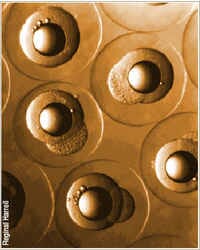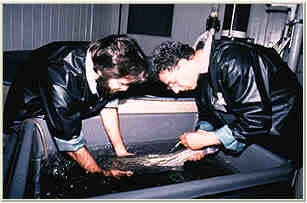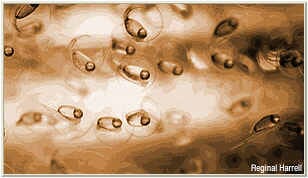 Josh Goldman, president of AquaFuture, one of the nation's leading striped bass growers, has spoken of the aquaculture industry's "extraordinary gains" he has also referred to it as "technologically primitive."
Josh Goldman, president of AquaFuture, one of the nation's leading striped bass growers, has spoken of the aquaculture industry's "extraordinary gains" he has also referred to it as "technologically primitive."
With only one finfish species, catfish, has U.S. aquaculture reached world class production harvest levels. From 1984-1986, for example, growers averaged some 230 million pounds a year, primarily in ponds in the southeastern states; over the last three years, they have doubled harvests to more than 450 million pounds annually.
 |
| Striped bass eggs shortly after they have been fertilized and before cell division. |
Increasing production while reducing costs will require a number of research breakthroughs that the industry can begin putting into operation, says Harrell, finfish specialist for the Maryland Sea Grant Extension Program and a scientist at the University's Center for Environmental Science (UMCES). To begin with, the industry needs year-round availability of seed fish, he says. "It also needs domesticated broodstock that can be bred for particular traits, such as faster growth and disease resistance." (See "Domesticating Striped Bass Broodstock".)
The research to meet these needs is underway in both university and industry labs, Harrell points out, "and we are beginning to see achievements that could make stepped-up production a reality in the next several years." First and foremost is the reproductive issue: researchers have been working to develop methods to reliably spawn striped bass year round in captivity and they are getting close.
The Problem of Spawning
A number one need, says Josh Goldman, "is having large numbers of juvenile fish throughout the year." That is not the case now: virtually all striped bass seed (eggs and fry) depends on collecting wild fish from their spawning grounds. In the few states that do not have restrictions, hatchery operators collect gravid fish (females ready to spawn whose eggs are near full development), transport them to the hatchery and, with a combination of skill and luck, says Harrell, maintain them until their eggs are mature. They generally need to inject the fish with a hormone (human chorionic gonadotropin) to induce spawning the eggs are then physically removed for fertilization.
The industry's dependence on collecting wild broodstock that are near spawning has been one of the major limits to its expansion. The difficulty of maintaining captive broodstock in hatchery raceways or tanks with the expectation that they will produce fully developed eggs has been immense.
"Broodstock stripers are just too finicky when it comes to spawning them," says Scott Lindell of AquaFuture. Captive stripers rarely undergo final egg development, let alone spawn. Consequently, the striped bass industry is really a hybrid one, in most cases making use of crosses between female white bass and male stripers these fish are referred to as sunshine bass.
Unlike stripers which may travel coastal waters for six years before returning to their natal areas to spawn, white bass are not migratory; they are also considerably smaller. For these reasons, they are not as sensitive when it comes to egg maturation and spawning they are much easier to manipulate, says Lindell.
While white bass reach maturity at one to three pounds, pure striped bass first reach maturity at 6 to 10 pounds, though many run from 15 to 50 pounds on the spawning grounds; it can take numbers of white bass to produce as many eggs as one or two large female stripers. Some years ago, research by Ed Houde at the UMCES Chesapeake Biological Lab showed that in addition to considerably more eggs per pound, larger striped bass produced higher quality eggs.
 |
| To provide the industry with striped bass seed, hatchery operators depend on collecting gravid striped bass from the wild, usually by electroshocking. |
In addition, white bass eggs and newly hatched fish are initially smaller, which can make the feeding of young hybrids more expensive and difficult: while growers must raise rotifers to feed the white bass fry, striper fry can be fed with freshly hatched commercially available brine shrimp. Potentially, with pure striped bass, raising fry could be simpler, says Steve Mitchell of Kent Sea Farms.
Even if wild stripers were more easily captured and spawned successfully, there are still disadvantages to relying on them, says Harrell. "You are dependent on the fish you happen to collect they may produce high quality eggs, they may not. You just don't know. It's totally random." "Furthermore," he says, "you can only get viable eggs at the time of natural spawning, a period of some four to six weeks." Consequently, all production for the year depends on that narrow window of time the same, of course, goes for white bass females. Currently, to harvest fish all year round, growers like AquaFuture and Kent Sea Farms "cold bank" them that is, they lower temperatures to slow fish metabolism, growth and egg maturation.
Everyone agrees that such dependence is unacceptable. For some time, researchers have been trying to "trick" striped bass into developing and spawning eggs by maintaining them in tanks with simulated environmental conditions especially daylight and temperatures, as well as salinities that they experience in the wild. Over this last decade, studies have shown that it is possible to spawn striped bass under such artificial photothermal cycles, says Craig Sullivan of North Carolina State University. However, he adds, the problem has been "the poor quality of the eggs or embryos."
This summer, though, Zohar and his group at COMB achieved a breakthrough: they spawned eggs from captive striped bass six months before the fish would naturally do so. They produced some three-quarters of a million fry from those eggs, fry that appear to be healthy, says Zohar. Many of the fish have been given to growers and researchers so they can track growth to harvest size.
This achievement by Zohar and his colleagues could represent a milestone for the industry. While the findings need to be replicated consistently and then refined for commercial use, Zohar says, hatchery operators could soon apply these techniques for producing striped bass or white bass seed year-round. In the long run, they would no longer have to depend on running out to the spawning grounds during a short period in April or May. Much like agriculture, they could better plan their production.
The Biochemistry of Spawning
Researchers have tried different methods for manipulating photoperiod, temperature and salinity in order to stimulate egg development and ovulation. The approach that Craig Sullivan and others have taken is to compress a year's cycle into six or nine months. Zohar's approach, based on earlier success with a number of other farmed fish, has been to expose fish to a phase shift that imitates exactly a year in the life of a fish. In other words, he simulates what a broodstock striped bass would experience over a year's coastal migration to the freshwater spawning grounds but shifts it by two, three, four, five months. Phase shifting in itself is not enough, says Zohar. "In the hatchery, stripers reach a certain stage of development and then stop."
The intriguing scientific questions for Zohar have had to do with the biochemical processes that prevent captive striped bass from producing viable eggs. "We knew that some hormonal failures were responsible," he says, "and though we had clues from previous work I had done on sea bream, we just didn't know."
 |
| Yonathon Zohar and John Stubblefield inject a striped bass with a hormone that stimulates spawning. |
There is a hormone it is key, he says that starts the whole chain of reproductive events: in the wild, the striper's biology responds to environmental cues by making the brain's gonadotropin-releasing hormone (a peptide referred to as GnRH); the GnRH induces the pituitary to release gonadotropins which induce egg development and spawning. In captive stripers, Zohar says, the gonadotropins are in the pituitary but the GnRH in the brain is somehow dysfunctioning either it is not released or not synthesized. Consequently the gonadotropins are not released.
While scientists knew of two GnRHs, Zohar's group discovered much to their surprise a third GnRH they refer to it as sbGnRH that turns out to be the most relevant for regulating egg development and spawning. "Our laboratory, as well as most of the scientific community," he says, "overlooked the most important form of gonadotropin-releasing hormones."
In using the techniques of biochemical engineering, the researchers designed superpotent versions, or analogs, of the native gonadotropin-releasing hormones for administering to captive fish. Zohar knew, however, that simply injecting these superpotent GnRHs would not be sufficient that is because they release an initial surge of gonadotropin for one or two days that is then broken down or eliminated by the striper.
 |
The implant technology for such sustained release of GnRHs is widely used in commercial aquaculture," Zohar says. "It is employed in more than 20 species of farmed fish throughout the world."
Zohar is excited about the future of this GnRH technology for striped bass culture and for other species. "We did the same thing for sea bream and sea bass some years ago," he says. "Based on the technology we developed, sea bream eggs are now being produced 365 days a year in different parts of the world we are getting close to being able to do the same thing for striped bass."
The uniqueness of the research for striped bass growers, says Steve Mitchell, is that everyone in industry and university labs is cooperating on their findings. "We're all working together," he says. "Broodstock manipulation is an example having fingerlings all year round is the goal. Once we have the most effective techniques, we don't have to think about getting the information out." That is Zohar's view as well: "I want to understand the fundamental processes of what is going on," he says, "but my approach is that it should work for the industry." Today, science is the vital principle of our civilization."
Source: Maryland Sea Grant - University of Maryland - September 1998.

